This post may contain affiliate links. We may receive a small commission, at no cost to you, if you make a purchase. Read Disclosure.
Joshua Tree National Park is special. Due to there being no cell service in the park, you can really be at one with nature and listen to your inner voice.
There’s something otherworldly about Joshua Tree. It’s like you’ve stepped onto a Mars-like planet complete with striking rock formations, sprawling cactus gardens, and of course, the iconic Joshua trees.
Straddling the high Mojave and low Colorado deserts, Joshua Tree National Park is small enough to explore in a day, but large enough to feel like a day well spent. There are plenty of things to do in Joshua Tree National Park, from hiking to stargazing, or simply enjoying the stillness of the desert.
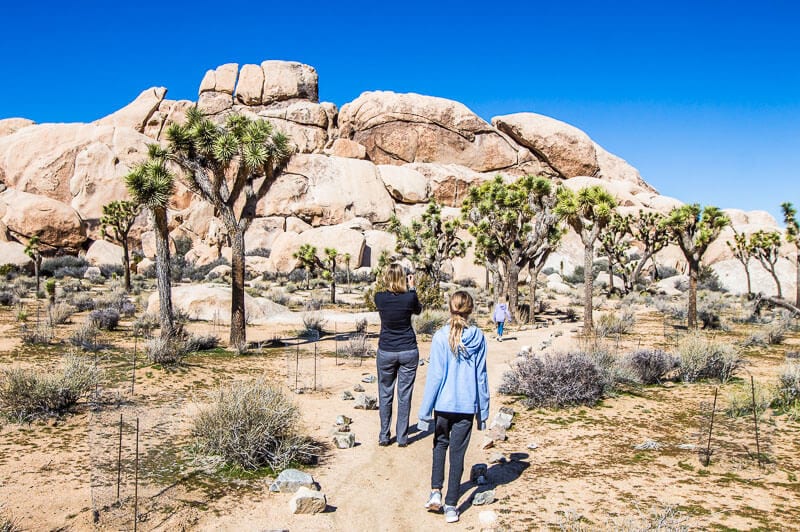
We spent two days exploring the park and have used our experience to present to you the best attractions and activities that we enjoyed doing in Joshua Tree National Park, as well as some tips for visiting and camping information.
1. Walk the Hidden Valley Nature Trail
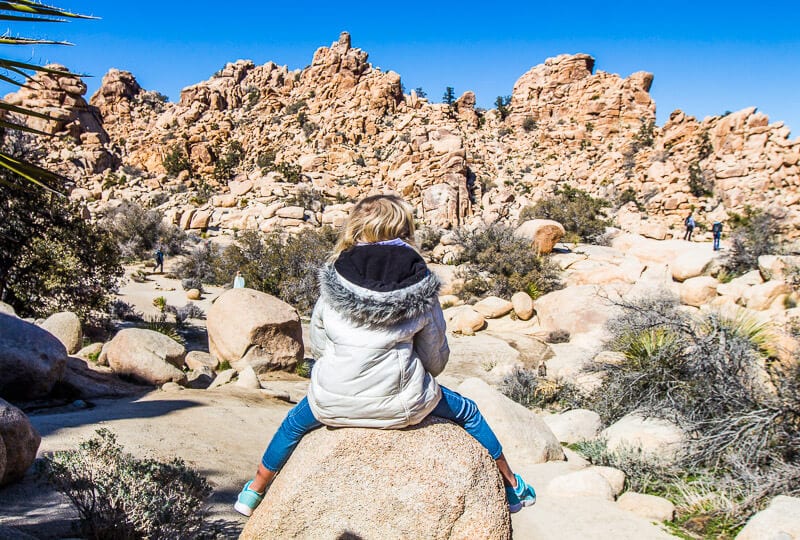
Hidden Valley is named after the cattle rustlers who used to hide their stolen cattle in here. Easy to see why when you walk through a narrow passage in the outcropping or rocks into a huge area bordered in a circle by more rock outcroppings. You would never know it’s there if you didn’t walk though the rocks.
It’s a very easy 1-mile loop walk around the perimeter of the valley. The scenery is spectacular with it’s white boulders and Joshua Trees dotting the landscape. Act like Savannah and find a rock to sit on and reflect.
Use your five senses to appreciate the park. Thank goodness for the Junior Ranger program that inspired her to do this. This area is popular for rock climbers with various climbing routes. Be sure to pack a picnic and enjoy at the Hidden Valley picnic area.
For beginning rock climbers with no equipment, you may wish to join this rock climbing tour!
2. Hike the Barker Dam Nature Trail
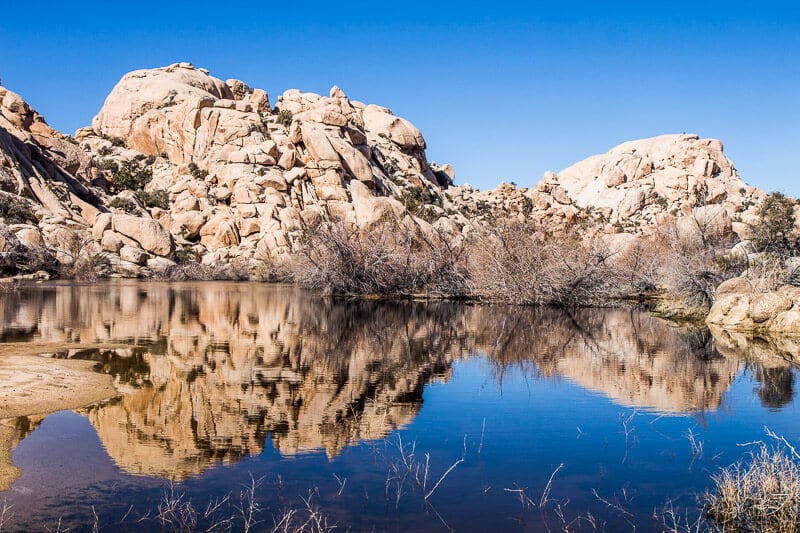
An easy hike for the whole family is to Barker Dam. It’s a 1 mile loop walk leading you around the edge of the reservoir by Barker Dam, which was created as a watering hole for the cattle.
It opens up to a gorgeous expansive vista of the surrounding mountains, rocks and Joshua Trees. Don’t forge to look out for the petroglyphs and pictographs on the rocks near the end of the trail. They are very vivid and interesting to look at.
It’s sad reading how some vandals had drawn over several in an area nearby. I just don’t understand why people want to destroy such natural treasures.
3. Hike the Ryan Mountain Hike
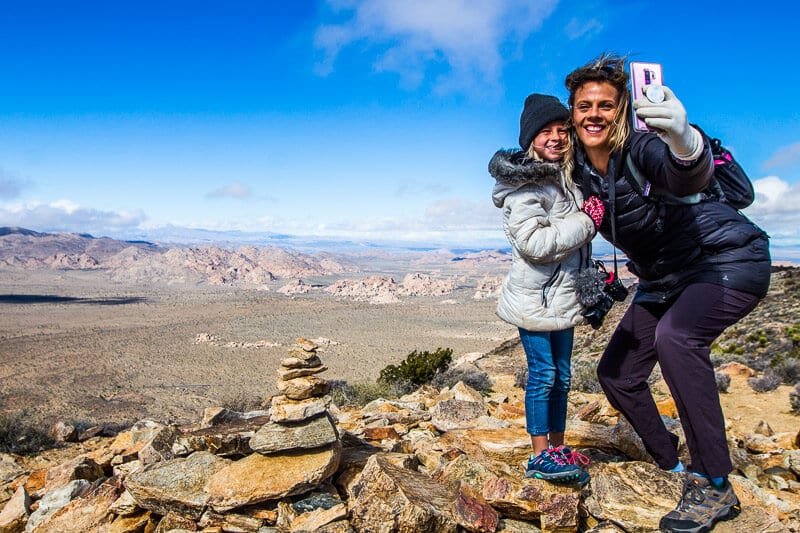
An exciting hike in Joshua Tree is to the top of Ryan Mountain. We had many people recommend this to us as one of the top things to do, and we can see why it’s one of the most popular hikes in the park.
Of course we decided to take the girls up there on the windiest day in the world, which only added to the adventure.
If you’re kids are used to hiking, they will be fine with this walk and will love the thrill of it.
The Ryan Mountain Trail is a 3-mile return hike and has a 1,000 feet of elevation gain to the 5,458 foot summit.
One one side of the mountain (the start of the tail) you get beautiful views of the rocky outcroppings in Lost Horse Valley, and on the other side of the short trail you get views of Queen and Pleasant Valley.
I would have liked to do the Fortynine Palms Oasis hike if I had more time. It’s a 3 mile walk to a shady beautiful oasis.
4. Admire scenic beauty on the Pinto Basin Drive
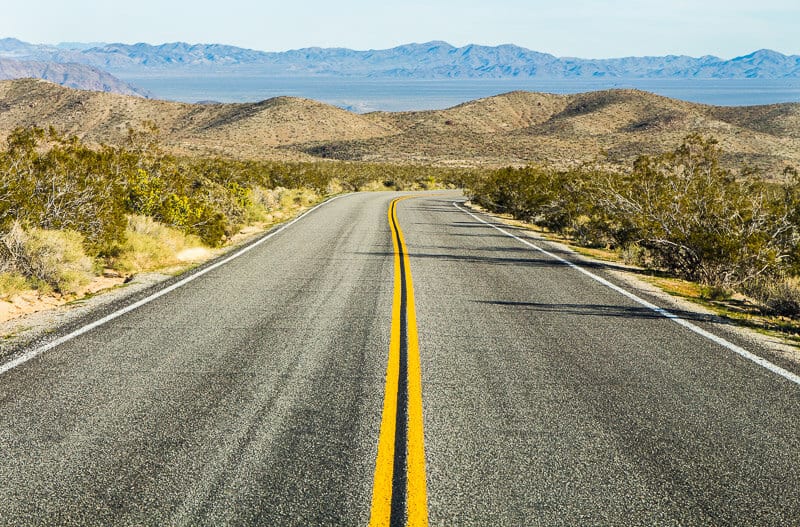
If you prefer not to hike, do this drive. We only drove the Pinto Basin road to a little beyond the Cholla Garden.
It’s quite a long drive and time was running short. We’re glad we made the call to turn around as it meant we experienced the extraordinary sunset at Key Views.
The drive is worth doing and if you have time, I recommend going all the way to the Cottonwood Spring Oasis, which was used by the Cahuilla Indian for centuries. The landscape changes quite dramatically along the way.
You lose the Joshua Trees and rock outcroppings and instead have a wide open expanse with mountains as the background as the Mojave Desert begins to meet the Colorado Desert.
5. Admire the beautiful Cholla Garden
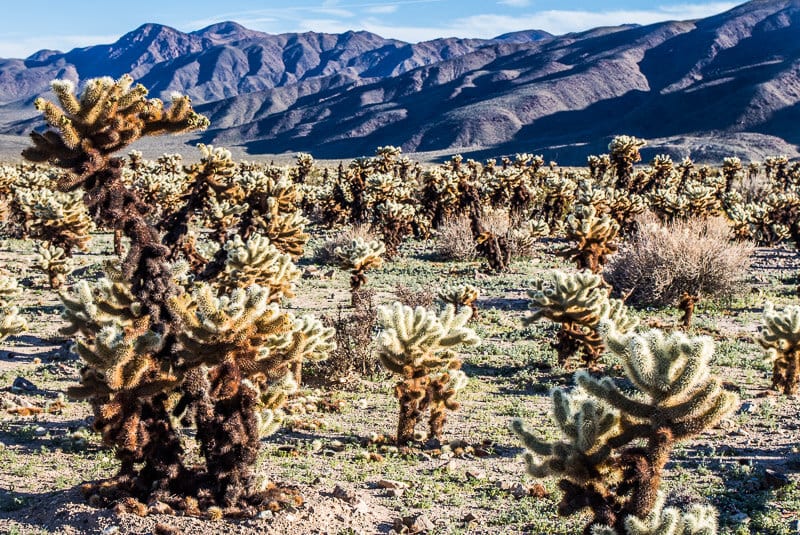
Kalyra was attacked by a cactus in the Sonoran desert in Saguaro National Park, and since then has stayed well clear of them. We returned to her foe, the jumping cholla. We hadn’t seen them since Tucson.
Along the Pinto Basin Drive you will come to a field of them. There are thousands! There is a boardwalk and path winding through the cholla cactus garden to protect you from them.
Don’t stray off the path. They’re called jumping for a reason, and they do like to embed themselves in your skin. You are close enough to admire them from the boardwalk. They really are beautiful and with the mountains in the background it makes for a gorgeous setting.
6. Snap a selfie with Skull Rock
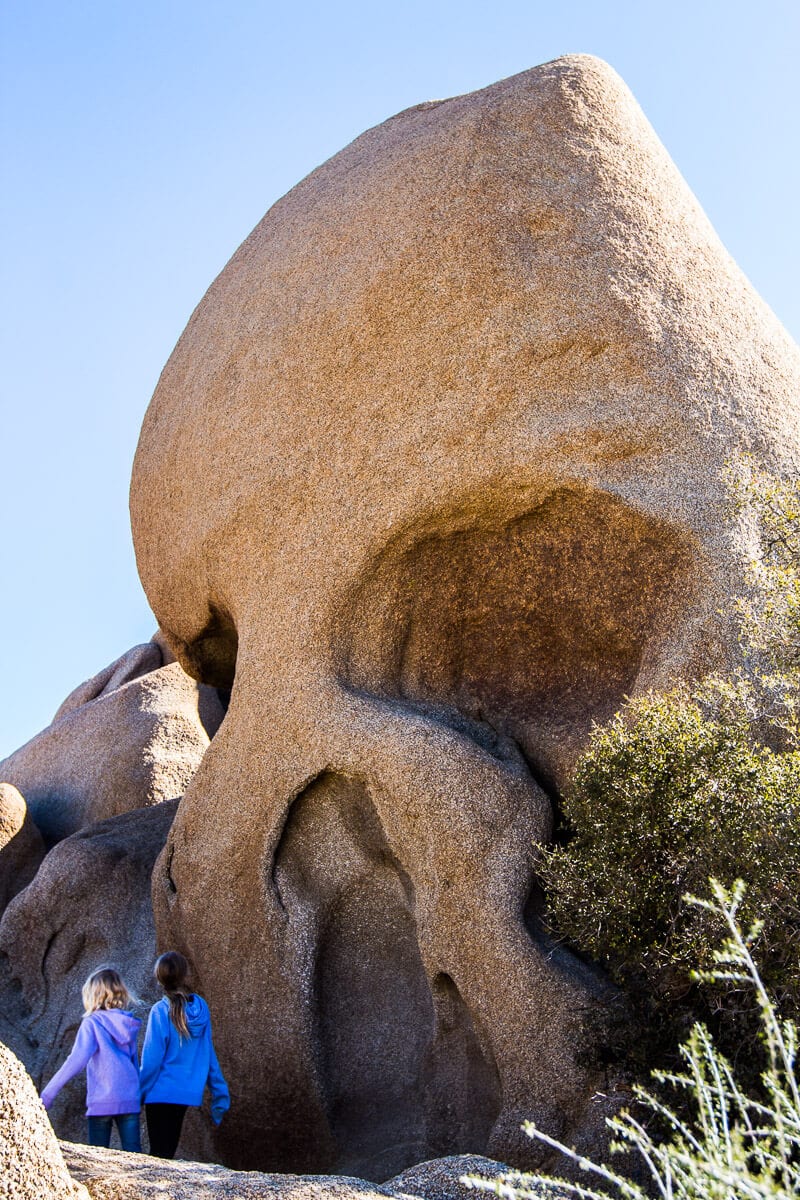
Be ready to line up for your photo with the haunting Skull Rock, the rounded shaped rock with a pair of shallow caves that resemble eye sockets.
It’s just off the side of the road so no hiking is required although there is a 1.7 mile nature trail around here you can take to the Jumbo Rocks should you wish.
7. Admire the sunset from Keys View Lookout Point
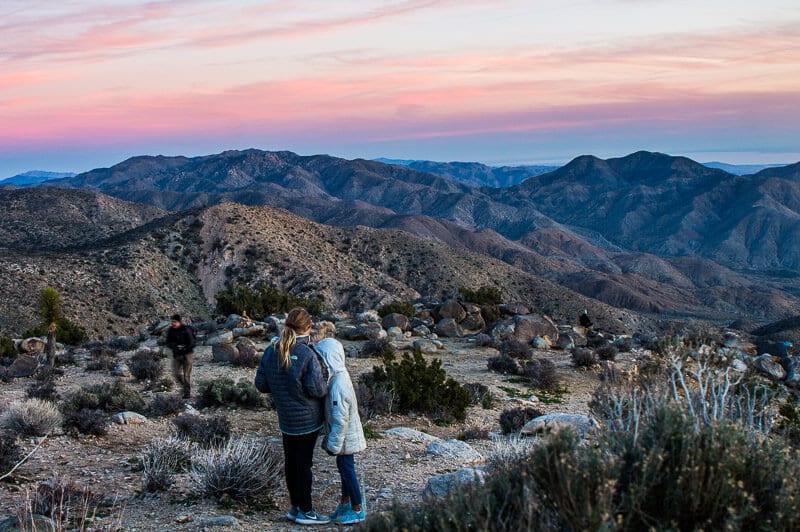
Be sure to end your day with a Joshua Tree sunset at Keys View, the highest point in the park with an elevation gain of 5,185 feet.
It’s just a short walk from the parking lot, and is one of the best spots in Joshua Tree to watch the sun go down!
You get a stunning 360 views of the a vista over the Coachella Valley, Palm Springs, Salton Sea and on a very clear day you can even see a mountain in Mexico. Even the famous San Andreas Fault, which bounds the south side of the park, can be observed from Keys View.
The sun sets behind Mt San Jacinto. Don’t forget to look behind to see the colors as well.
8. Engage your kids in the Junior Ranger Program
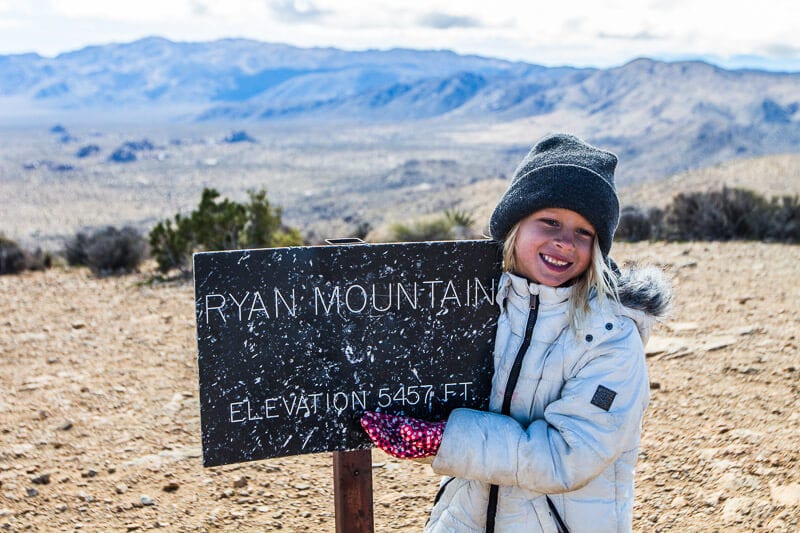
Don’t forget to stop in at the Joshua Tree Visitor Center with your kids to grab your Junior Ranger program. This is the best way for children to engage with the National Park experience.
We LOVE this workshop. The girls take charge of their own learning and are becoming fantastic stewards of the Earth as a result.
The activities will help them learn in an effortless and fun way about the flora and fauna of the park and what makes it so special.
It’s a great way for them to reflect on what they have learned and accomplished at the end when they turn their booklet in to receive their badges. A ranger will talk to them about their answers and experiences within the park.
Kane, the ranger on duty, was so funny and wonderful in how he interacted with the girls. We all found it especially funny when Savannah shared the smells she experienced in the park: rosemary and farts!!
The kids say a pledge with the ranger at the end promising to protect the park and then they receive their badges!
We’re doing our best to collect as many as we can. We have two Grand Canyon badges and would have had Saguaro National Park and Big Bend National Park, had the government shutdown not gotten in the way.
10. Dine at Pappy & Harriet’s near Pioneertown
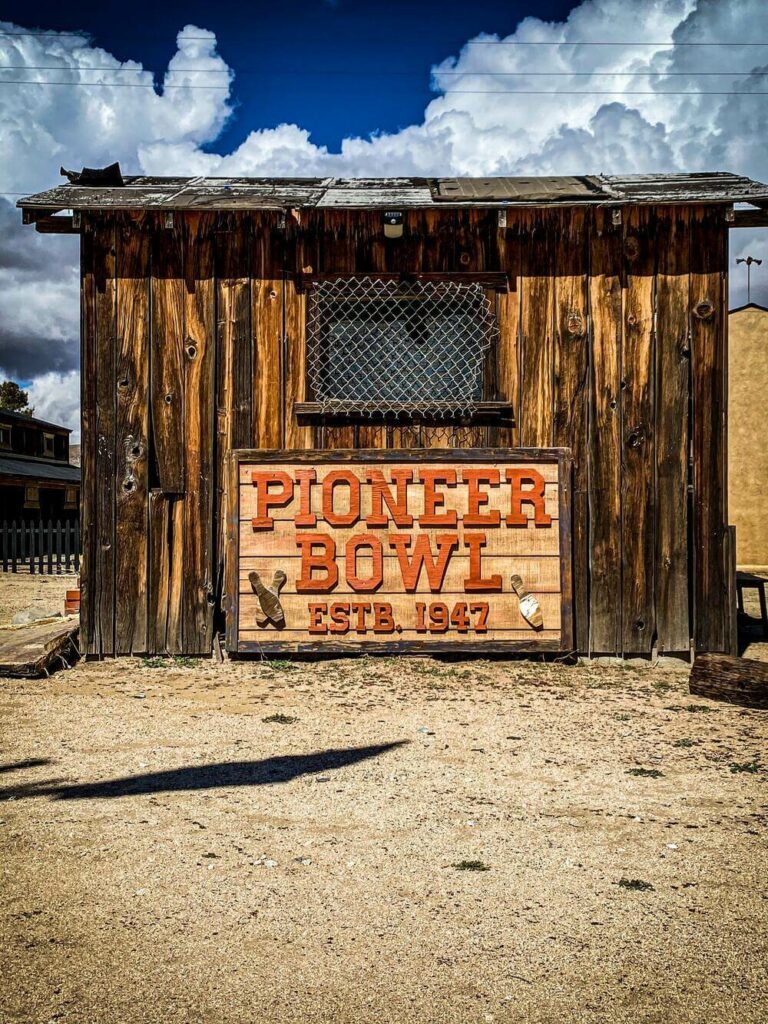
Pappy & Harriet’s is a barbecue restaurant that has become famous for being one of the very few consistent music venues in the desert.
It’s located in the middle of nowhere, 15 minutes drive outside Pioneer town, but still managed to book the likes of Paul McCartney, Rufus Wainwright, and Vampire Weekend.
You can grab traditional American food such as burgers or mac & cheese, and watch a show.
11. Visit the Noah Purifoy Outdoor Desert Art Museum & Assemblage Sculpture
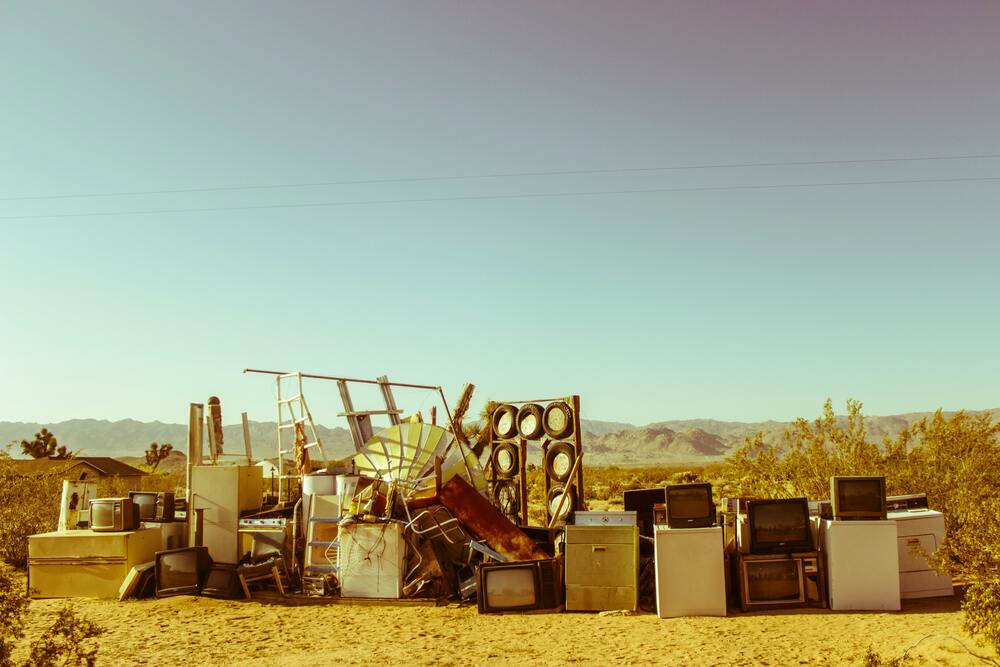
The Noah Purifoy Desert Art Museum is a modern art museum that is most famous for housing an art installation, called 66 Signs of Neon, which was constructed from debris from the Watts Rebellion.
You’ll find many sculptures and installations at the museum, and they are all quirky and interesting. It’s free to enter, but of course donations are welcome.
Noah Purifoy spent most of his life living and working in Joshua Tree and in LA, and constructed the outdoor gallery to display dozens of large and unique pieces of art.
12. Visit Keys Ranch
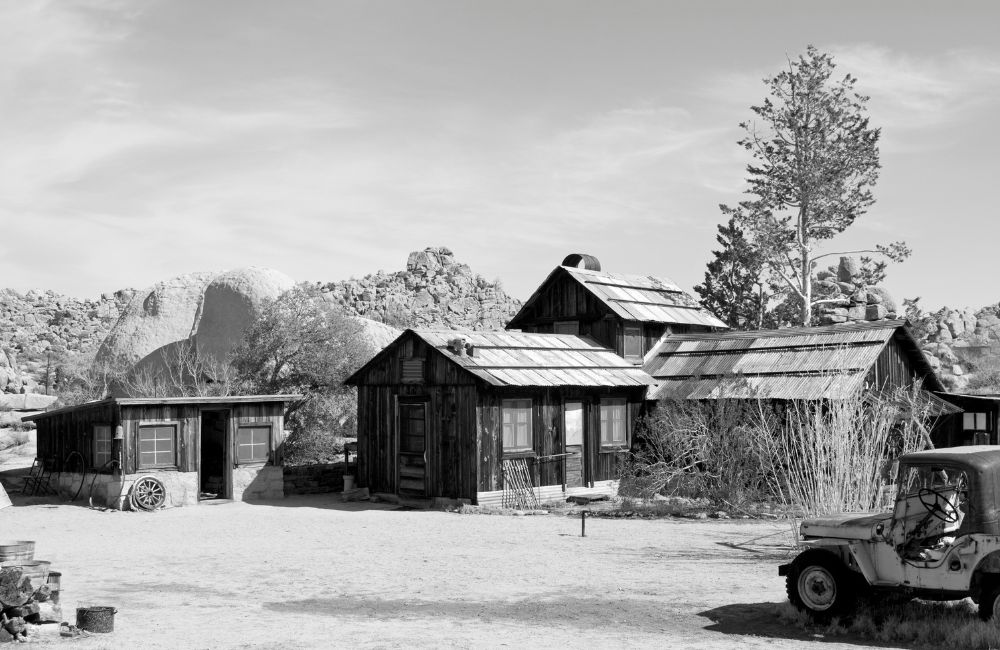
Keys Ranch is the former homestead and ranch of William F. Keys and is located in one of the few hospitable places in the park.
Keys decided to settle in this area in the 1910s and the property is now part of the National Historic Register. Guided tours of the house, schoolhouse, store and workshop are available by rangers, and this is the only way to see the property.
Tours only operate in the winter and into spring and offer informative insights into how the family was able to survive out here in the desert.
Make sure to book your tour early, as they often sell out! Tours run on Friday, Saturday and Sunday and are only limited to 25 people per tour.
13. Go biking along the Back Roads
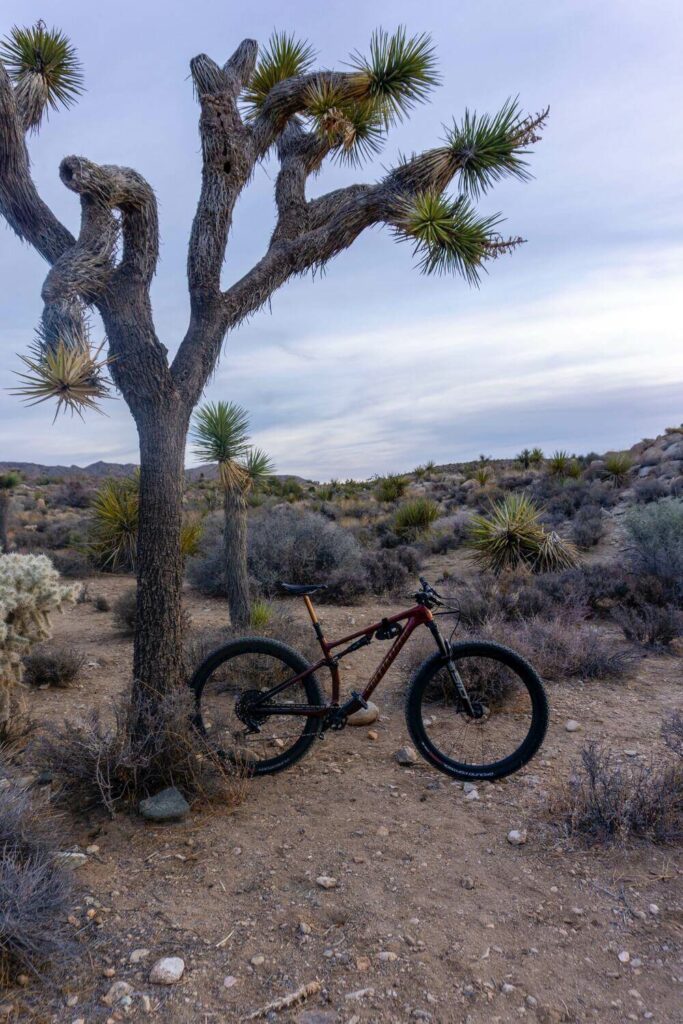
We loved getting of the maintained hiking trails and taking a mountain bike along the dirt roads. Since there are no bike roads, and all cycling must take place on the roads accessible by vehicles, dirt roads are the best roads for cycling as vehicles tend not to go down them and flatten the terrain.
This is a great way to see all the sites of the park and just admire its natural beauty – as well as get some exercise!
Some of the best areas to bike to in the park are:
- Upper Covington Flat Road
- Eureka Peak Road
- Lower Covington Flat Road
- And across the Covington Flats Crossover Road
History of Joshua Tree National Park
In the 1930s desert lover and community activist, Minerva Hoyt recognized the human threats to the nearby ecosystem and persuaded President Franklin D. Roosevelt to proclaim Joshua Tree a National Monument in 1936.
It was renamed the Joshua Tree National Park in 1994 and now protects 792,510 acres – mostly wilderness – where the Mojave and Colorado Deserts converge.
Thanks to Minerva, we have this national treasure where we can disconnect from the chaos of our busy lives to unwind and relax amongst the stark beauty and unique desert trees.
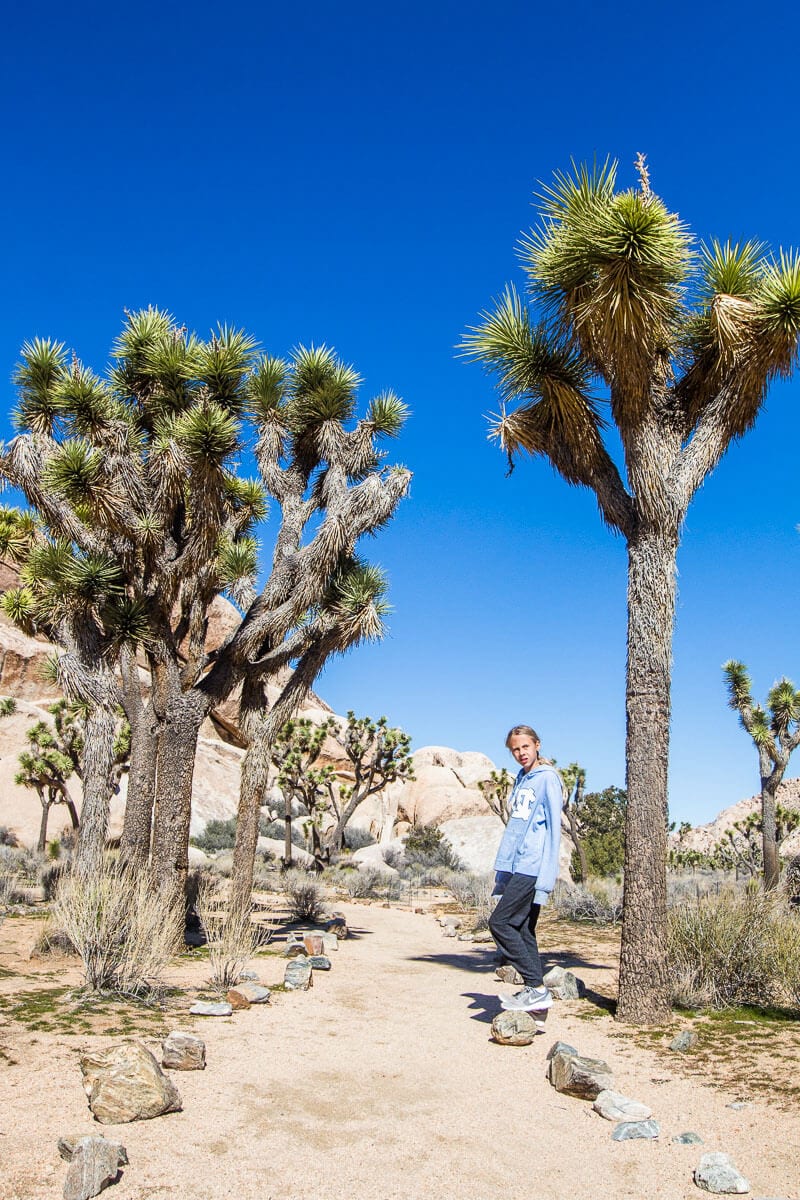
But what’s special about Joshua Tree? It’s not just the Joshua Trees to love here but junipers, scrub oaks, Mojave yuccas, and prickly pear cactus, one of our favorites from Big Bend National Park.
One of the interesting Joshua Tree facts is that it isn’t really a tree, but a species of yucca! They can grow over 40 feet tall at the leisurely rate of an inch a year – typical of a desert plant.
In February through April it blooms clusters of cream-colored flowers. We just missed it!
It’s also home to a wide variety of animals such as ground squirrels, bighorn sheep, woodpeckers hawks, ravens and desert tortoises. We saw a couple of jackrabbits and ground squirrels during our visit.
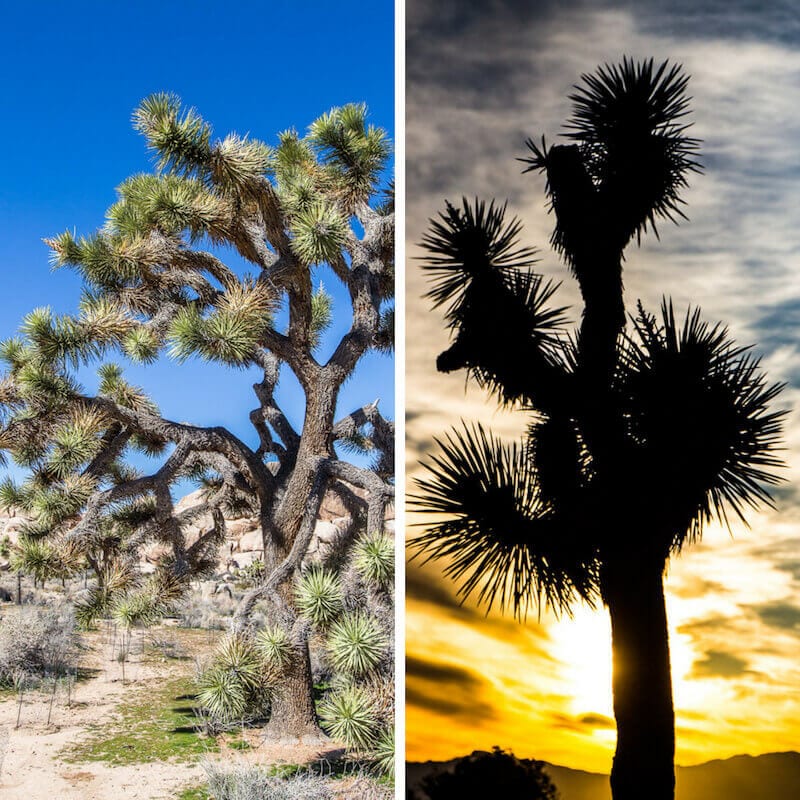
It’s only in the Mojave Desert section of the park (the northwest section) where you’ll see most of the Joshua trees. The south is dominated by the flora and fauna of the Colorado Desert which has lower elevations. Here is where you’ll find cholla, creosote, and ocotillo.
You won’t see any more of those beautiful piles of rock boulders either, created as a result of volcanic activity. There are a few fan–palm oases within the park. Fan palms are so majestic and magnetic. I loved them as much as the Joshua’s.
The oasis will also have cottonwoods and mesquites, more plants of the desert I love.
Opening hours and entrance fee
Joshua Tree National Park is open year-round, 24 hours a day. The park welcomes visitors around the clock. The Visitor Center opens at 7:30 AM and closes at 5:00 PM daily.
Entrance fees are $30 per vehicle, $25 for motorcycles, or $15 for those arriving on foot or bicycle, each pass valid for seven consecutive days.
For desert devotees planning multiple visits, the $55 annual Joshua Tree Pass offers unlimited access. A great excuse to keep coming back for more of that otherworldly magic.
Getting to Joshua Tree National Park
Joshua Tree National Park is situated in San Bernardino County in South East Southern California and within a few hours’ drive of several major cities:
- LA to Joshua Tree is 140 miles
- Palms Springs to Joshua Tree is 49 miles
- 175 miles northeast of San Diego
- 215 miles southwest of Las Vegas
- 222 miles west of Phoenix
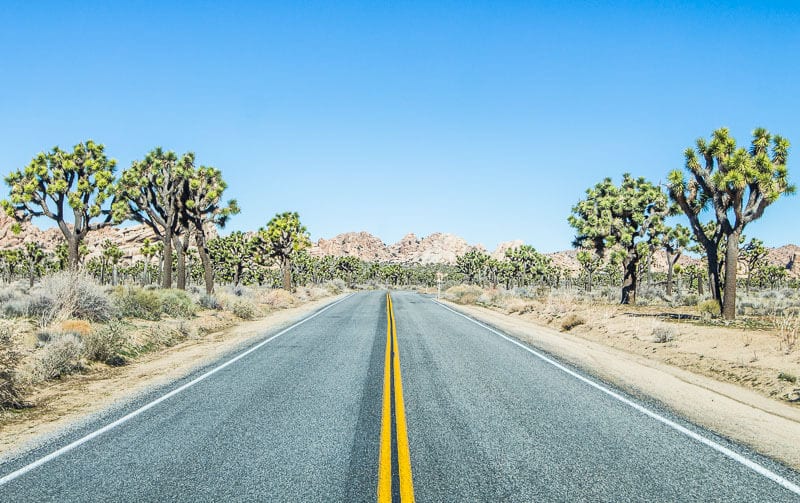
Joshua Tree is easily accessible from Los Angeles (140 miles), but you will need a car as you need one to explore the park. You can rent a car from Los Angeles, or Palm Springs. The nearest airport is Palm Springs International Airport (44.5 miles, 1 hour drive away).
There is an entrance at Twentynine Palms (North Entrance), Joshua Tree Village (West Entrance), and near Cottonwood Springs (South entrance).
Although we recommend traveling to Joshua Tree National Park independently, if that is not possible for you there are Joshua Tree tours you can take from LA or Palm Springs.
Learn more about tours to Joshua Tree here!
Can you see Joshua Tree National Park in a day?
Joshua Tree National Park is small enough to see most of it in one day. It will involve an early start and late finish, however, and you’ll want to take your food and drinks inside the park with you.
However, there is plenty to do to extend it over several days and I always say, why not?
What can you do in Joshua Tree in one day? My recommendations would be:
- Ryan Mountain
- Skull Rock
- Hidden Valley Trail
- Barkers Dam
- Cholla Garden
- Keys View for sunset
How long you spend in the park is very much dependent on the traveler, but if you were to drive through the park and only see the sites from the car, you can see everything in four hours. However, you won’t get to experience the magic of the place if you rush it.
We think you should allocate a full 12 hour day, or if possible, spend two days in the park. Spend a night camping in the park and really feel the magic of the place. It’s a dark skies park, so stargazers will love looking up at the Milky Way at night.
It’s also way more majestic at sunrise!
What is the best time to visit Joshua Tree?
The best time to visit Joshua Tree National Park is in the spring and autumn as the weather is just right this time of year. The best months are March – May and October – November.
You can visit the park all year-round but the weather in the summer is extremely hot, and that temperature can vary depending on where you are in the park.
The winter brings in the rainy season from December until March, and while it doesn’t rain all the time, the weather is unpredictable this time of year.
Tips for visiting Joshua Tree National Park with kids
Before you go, we have just a few words of advice for you about visiting Joshua Tree National Park, especially if you are visiting with children.
- Watch where you put your hands and feet – rattlesnakes live here!
- Only rock climb if you know what you are doing.
- Be careful of flash flooding, especially if you visit in the winter.
- Off road driving is not permitted in Joshua Tree California
- There is no cell phone coverage in most of the park – yay. Enjoy being present! I recommend downloading an offline map, such as Maps.me, so you can still have access to navigation from within the park.
- Camping is allowed only in designated areas or with a backcountry permit.
- Joshua Tree Visitor Center, Oasis Visitor Center in Twentynine Palms, and Cottonwood Visitor Center are open daily.
- Blackrock Nature Center is open October through May.
Where to stay near Joshua Tree National Park
Although you can see Joshua Tree in a day, it’s a good idea to find a place to stay in the Yucca Valley area before you visit so you can spend an entire day exploring. You can stay in the town of Joshua Tree, or a little further away in Palm Springs.
Here’s where we recommend:
Camping in Joshua Tree National Park
There are nine Joshua Tree campgrounds inside the park that offer a total of 500 campsites, plus a handful of campgrounds outside the national park but near Joshua Tree.
Only Black Rock, Indian Cove, Sheep Pass, and Cottonwood Group campgrounds accept reservations from September through May. The rest are first come first served.
Campsites can be booked up to six months in advance, as well as on the day. Finding a campsite mid-week is easier than on weekends in peak Joshua Tree camping season (Jan – May, Oct – Dec).
Joshua Tree campgrounds have (basic) toilet facilities. All campsites have picnic areas with tables and fire rings, but you must bring your own firewood!
If you’re not sure which campground to book, I recommend White Tank Campground, located off Pinto Basin Road in the northern end of the park. It’s a first-come, first-served campground. It’s close to the popular Arch Rock Trail and there are incredible night skies here as it’s located near the darkest section of the park.
Learn more about Joshua Tree National Park camping here, and for Joshua Tree camping reservations go here.
29 Palms Inn at Oasis of Mara
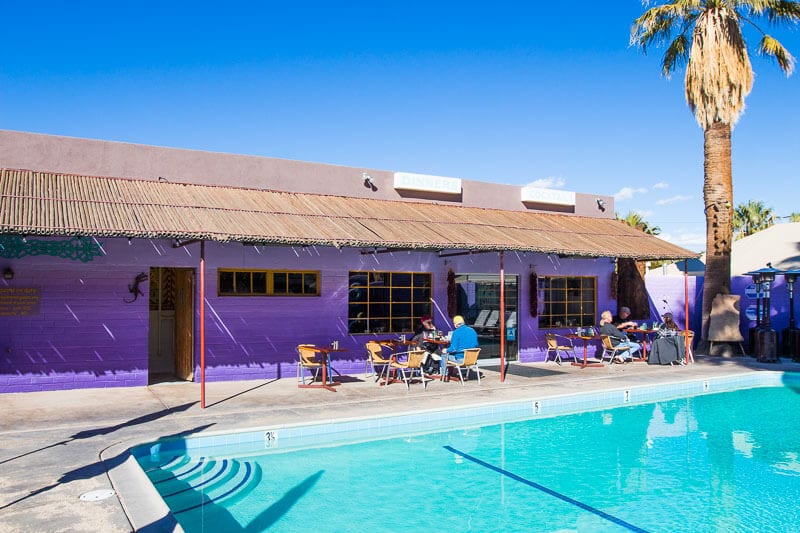
Established in 1928, the 29 Palms Inn offers an eclectic mix of guest accommodations looking out to the mountains of Joshua Tree National Park.
Oasis of Mara is also home to the park headquarters and the Oasis Visitor Center.
American Indians were the first people to live here, followed by prospectors than homesteaders. It’s really beautiful and a serene place to stay here in a cute desert cottage.
We ate here for lunch and had a look around the grounds and learned a little about the organic gardens where they grow a lot of the produce for their kitchen.
Campbell House
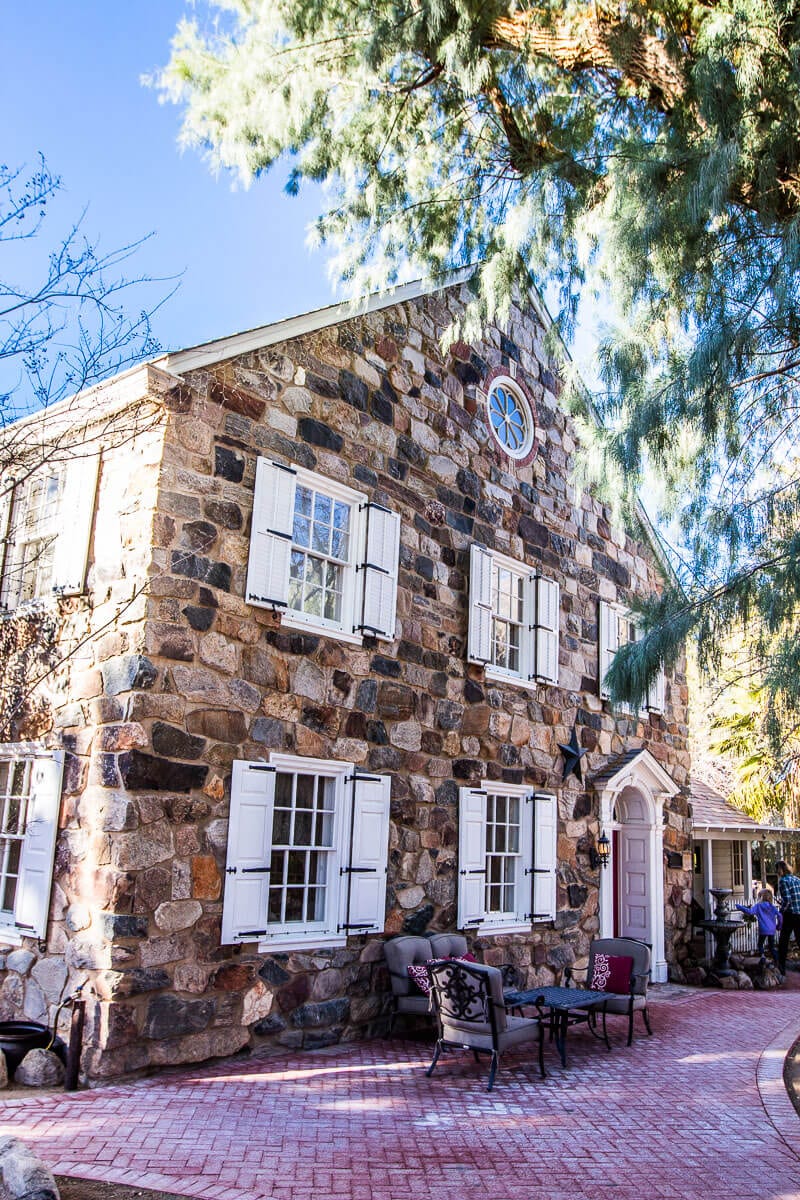
Oh this place is divine! What a great way to relax after a long hot day in the desert.
I loved the outdoor sitting area shaded by those gorgeous fan palm trees. There’s also an outdoor hot tub and swimming pool and you can stay either in a room in the main colonial home or cottages on the property.
Campbell House is a Philadelphia-style Colonial house situated in Twentynine Palm. The original homestead was built in the 1920s by Bill & Elizabeth Campbell and is still present today attached to the main house as the lobby.
You can view more properties around Joshua Tree National Park in the following map:
Final thoughts
In Saguaro National Park in Tucson, we fell in love with the saguaro cacti. Here in South East California, we fell in love with the Joshua Tree, which reminded me so much of the truffula trees in the Lorax. It has a similar playful, unique, and striking presence and aura.
The longer I live, the more I love the desert, and Joshua Tree is one of the best places to visit in California and one of our favorite national parks in California.
The desert used to bore me as a child and wondered why anyone would want to visit as wasteland. Now I know it as a place full of life and the chance for spiritual awakenings and soul love.
When you’re at the oasis, know you are standing at the top of a crack in the Earth’s crust!! But try not to think about the shakes that have to occur along the faultline here!!
We hope this guide has helped you decide on what to do here and helped you plan your visit. Happy exploring!
More California Travel Tips
Want more tips for places to visit nearby in California? Here are some other helpful guides…
More National Parks in the USA Inspiration
Are you thinking of visiting more national parks in the United States? Then you’ll enjoy these helpful resources:
Pin To Save On Pinterest
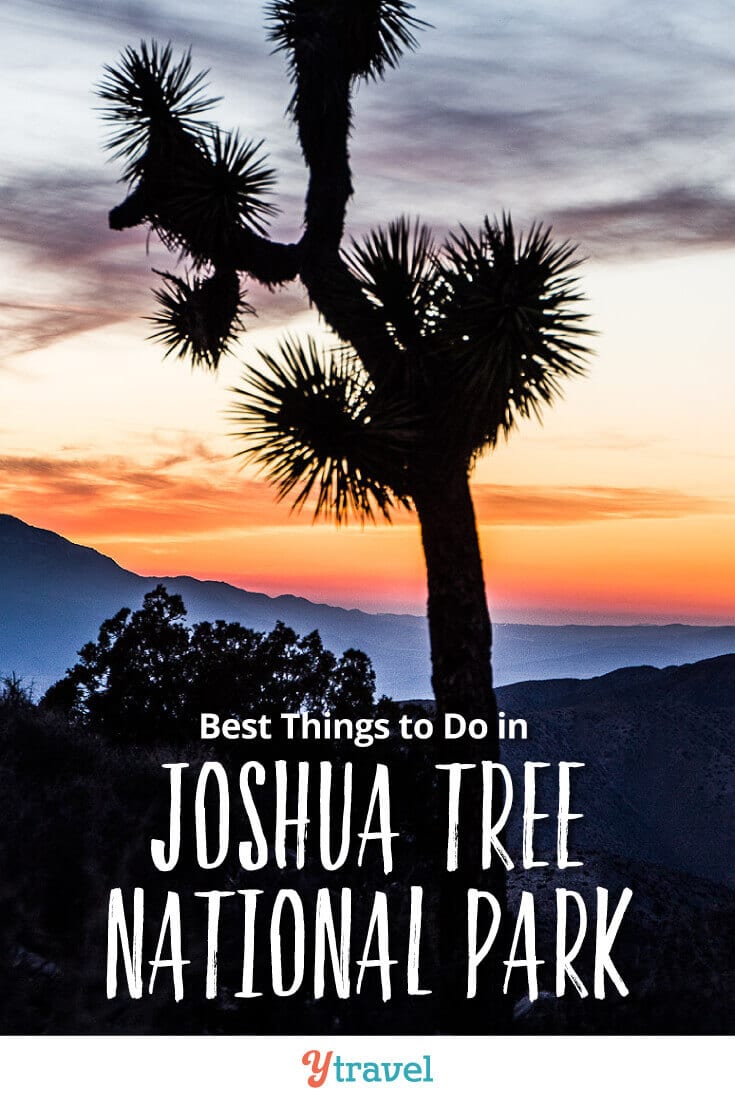
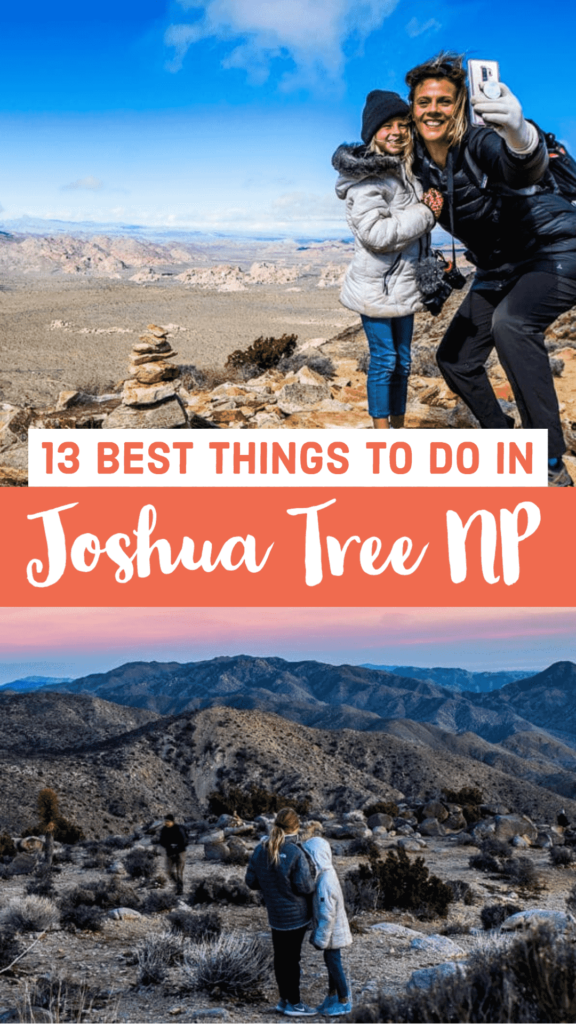
What are you most excited to do in Joshua Tree National Park? Leave a comment down below!


